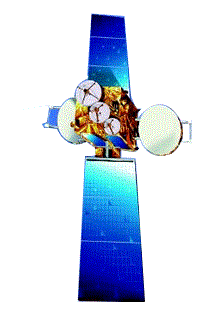 | |
| Mission type | Communications Weather |
|---|---|
| Operator | INSAT |
| COSPAR ID | 2002-002A |
| SATCAT no. | 27298 |
| Website | INSAT 3C |
| Spacecraft properties | |
| Bus | I-2K |
| Manufacturer | ISRO |
| Launch mass | 2,750 kg (6,060 lb) |
| Dry mass | 1,210 kg (2,670 lb) |
| Power | 2.765 kilowatts |
| Start of mission | |
| Launch date | 23 January 2002, 23:46:57 UTC |
| Rocket | Ariane-42L H10-3 |
| Launch site | Kourou ELA-3 |
| Contractor | Arianespace |
| Orbital parameters | |
| Reference system | Geocentric |
| Regime | Geostationary |
| Longitude | 74° East ( 0°N74°E / 0°N +74°E ) |
| Inclination | 4 degrees |
| Period | 24 hours |
INSAT-3C is a multipurpose satellite built by ISRO and launched by Arianespace in Jan 2002. [1] INSAT-3C is the second satellite of the INSAT-3 series. All the transponders provide coverage over India. Insat-3C is controlled from the Master Control Facility at Hassan in Karnataka. It will provide voice, video and digital data services to India and neighboring countries.
